Capital:
Dhaka
Currency
Taka
Best time to visit:
Winter (November to February) is generally the best time to visit Bangladesh. It is advisable to avoid the monsoon rains that begin in June and can last until September.
In a word:
Salam Alaykum (good morning)
Vaccines
None
Warnings:
– Avoid travelling at night because the roads are not lit and few road rules are respected;
– Protect yourself from mosquitoes with good repellents because of dengue;
– Avoid renting a car because driving alone is really very difficult.
At the table:
Bangladeshi food can be very spicy so always inform the waiter before ordering. Here are some typical dishes:
Gustor torkari (chicken curry); Dim Buna (curry with boiled hard boiled eggs); Murali (a sweet, similar to breadsticks, hard and floury on the inside and sweet on the outside); Khichuri (rice based dish with lots of spices, turmeric, chilli and pulses) and Biryani.

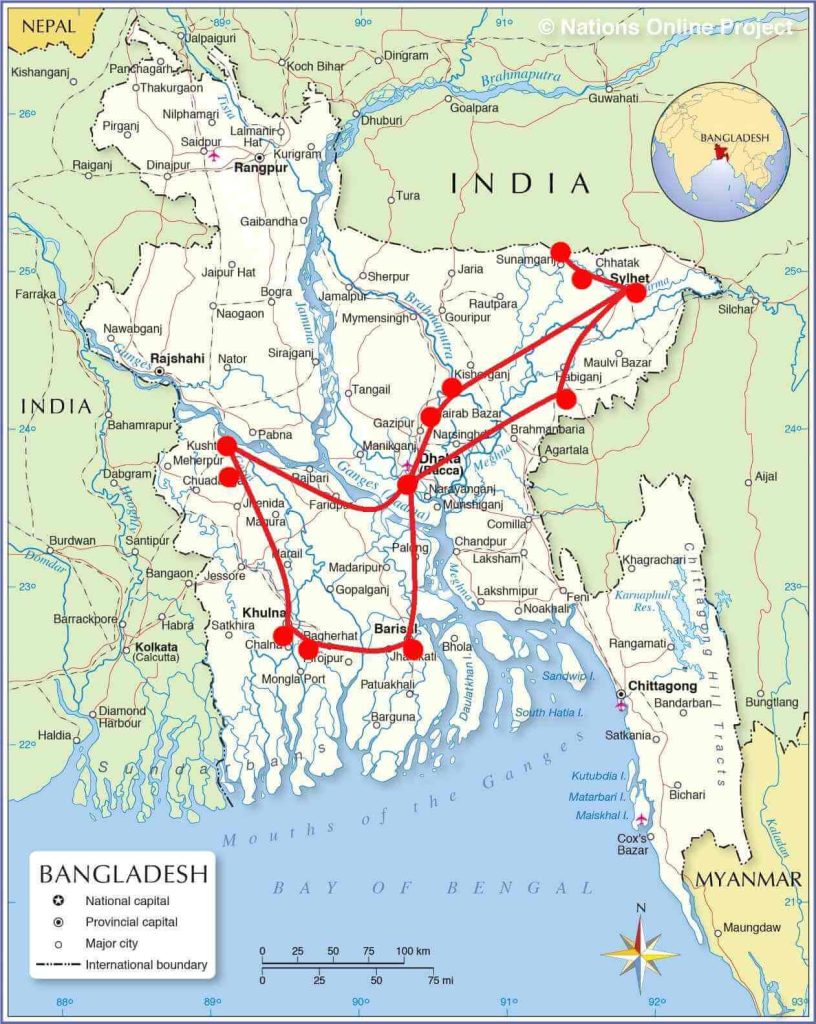
Essential experiences:
Cruise along the canals of Banaripara through the picturesque floating market; Get lost among the tea or pineapple plantations in the Sreemangal area; Spend a night on the ferry from Dhaka to Barisal among street vendors and smiling locals; Taste a delicious kazha (sugar sweet) in Kushtia.
Taking a two-week trip to Bangladesh means immersing yourself in a world of extraordinary authenticity and genuineness.
This fascinating Southeast Asian country, often overlooked by traditional tourist circuits, offers a unique mix of ancient history, vibrant culture and breathtaking landscapes.
Our tour begins in the lively capital Dhaka, a pulsating heart of energy and contrasts, where the urban chaos of old, worn-out buses and noisy tuk tuks and rickshaws mixes with centuries-old historical and traditional treasures.
From here we will venture towards picturesque villages, majestic temples and mosques, lush mangrove forests, we will navigate the waters of large rivers to discover the most distant corners of the country.
Get ready to discover a Bangladesh ready to give you unforgettable emotions off the beaten track.
Our suggested itinerary (12 days) | |
three days: | Dhaka (visit to Gulshan Circle; Curzon Hall – university area; the monument symbol of the Bengali independence struggle: Shahid Minar and the crowded Shakhari Bazar); Banti (creation of batik, fabrics, rice paddies and bricks); Sylhet; Jaflong (visit to the border with India) |
three days: | Sreemangal (tea plantation and pineapple plantation visit); Lawachora NP; Tripura (tribal village visit) |
two days: | Dhaka (visit to Karwan Bazar; Tara Masjid (Star Mosque); Dhakeshiwari Hindu Temple and Sadarghat Port); Night ferry |
four days: | Barisal; Banaripara (visit to the floating market); Shohagdal (tribal village); Bagerhat (visit to Shat Gambuji Masjid); Kushtia (Shrine of Lalon Shah); Puthia (visit to the Palace of the Kings); Pahardur (visit to the Vihara temple); Bogra (Visit Mahasthan Bazar Market) |
We organized this trip, in collaboration with Riverain Tours, of the mythical Bulu and with theBangladesh Tourism Board. Bulu [[email protected] - w.app: +8801712292871] today welcomes us with open arms in his country and we strongly recommend relying on a local tour operator especially for the transfers part otherwise the trip would risk becoming much more complicated than it is given the insufficiency and reliability of transport.
Dhaka: the super chaotic capital!
We will stay at Bengal Inn, a very nice hotel in the center located in one of the poshest neighborhoods of the city and very close to Gulshan Circle, the trendiest area of Dhaka.
We begin the visit paradoxically from the quieter area Curzon Hall, an example of British colonial architecture, which today houses an impressive university complex with all the most important faculties. Nice to see the new generation making their way in this still quite closed society!
Not far away stands the Shahid Minar, a symbol of Bengali nationalism, this monument was built to commemorate the martyrs of the “Language” movement who fell in 1952 when a group of students rose up against the Pakistani military, who governed them, refusing to adopt Urdu as the national language.
We end the day trying to find our way through the narrow, crowded streets of Shakhari Bazar, past artisan shops and honking rickshaws stuck in traffic.


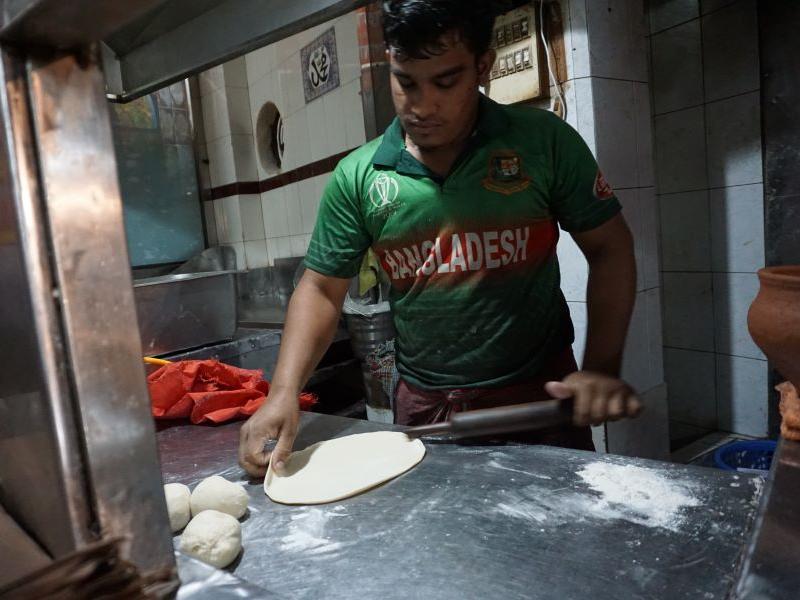
Very long day of transfer from the capital towards the north-east Sylhet near the border with theIndia, one of many.
The day is enriched by many experiences that lead us to witness the daily life of these people so distant from us.
We first stop to visit a couple of villages: in Banti they produce fabrics and batik, here we see all the various phases from dyeing to wax with the various designs to the final rinse in boiling water before being laid out in the sun. All very interesting.
We move on to the rice paddy area and see hard-working women gathering the raw rice after having spread it out in the sun to dry it, ready to be put into sacks.
Further on is the brick-making area and here too we follow the various phases: from collecting the earth to kneading to create a soft clay, to the formation of the bricks up to their firing… This too is very interesting.
What struck me today was the great genuineness of these people, always well-disposed, welcoming, curious and amused by our presence, especially that of Nora and Jago.
We spend the night at the Crystal Rose Hotel of Sylhet, a very nice hotel not far from the city center.
Today we head towards the border withIndia, we immediately notice many buses full of local tourists when we arrive in Jaflong.
There is a large gate that greets those leaving Bangladesh and another that welcomes those entering India.
What a thrill, India in front of us!
We discover that this is a real tourist destination for Bangladeshis who come here to take numerous selfies in front of the border, take a bath in the river and eat the street food that can be found almost everywhere.
Not far away we take a boat to sail to “point zero”, another border with India, but be careful not to cross it.
The navigation is very pleasant… The blue waters meet the darker ones creating a beautiful effect while fishermen fish in peace and a group of boys wash themselves on the edge of the river.
We set off again towards Sreemangal where we will spend this night…. The journey is long, complicated, sometimes scary because of the endless cars, trucks, tuk tuks, buses that speed in all directions, then at night, but our artist Rais is really super!
We sleep at the Shantibari Eco resort, located in the heart of the tea plantations. We arrive at night so we can't immediately understand where we are.... I even check our position on Google Maps and from above I see many lakes and green plantations.
When we organized this trip I was very afraid of this night because of the mosquitoes, but thanks to the kindness of the staff and two beautiful mosquito nets we spent a peaceful night lulled by the croaking of the frogs in the various ponds surrounding our room.
Waking up at Shantibari Eco Resort and seeing the peaceful and lush background was very exciting, arriving at night we had not realized where we really were.
This morning we took the opportunity to take a trip to Lawachora NP, home of the Ulock gibbons… We were lucky enough to see an entire family jumping from tree to tree past several very large spiders.
We stop to visit a small tribal village (Tripura) and we are very impressed by the daily life of these people who struggle so much with the few means available to get by but they do so with great dignity.
We also visit the only school in the village, a Christian one, and it is a great party with the drone and the children. Here we leave almost all the medicines we had brought (mostly paracetamol) and we feel so proud looking at the gratitude of these people.
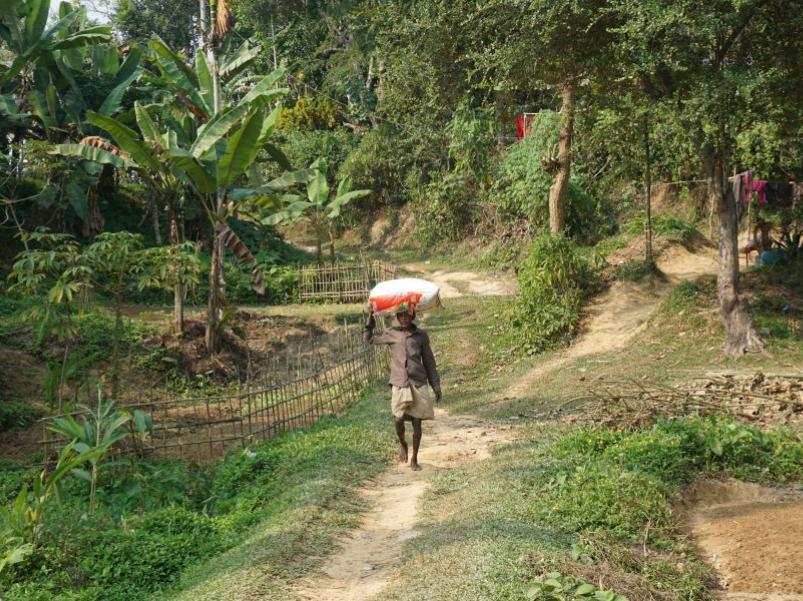





But this is also the area of the large tea plantations… They are immense, they extend as far as the eye can see and even the drone struggles to fit all the images into one frame.
We also see a large pineapple plantation for the first time and taste these freshly picked and peeled fruits: a delicacy.
Before leaving for the capital we stop to taste a very special tea, a seven-colored tea: seven layers of seven different colors.
The return to Dhaka is very tiring… We cover just over 100 km in 4 hours due to the incredible traffic.
In the evening we return to our lovely Bengal Inn hotel and are so tired that we order dinner in the room while we recover with a relaxing shower. Really delicious dinner.
This morning we dive straight into the super chaotic Karwan Bazaar, open from three in the morning and always buzzing… Here you can find everything! And we are simply enchanted watching everyday life pass before our eyes.
In the late morning we even meet the CEO of the Bangladesh Tourism Board at their headquarters, a very pleasant meeting.
In a rickshaw we wander through the crowded streets of the city among thousands of other rickshaws, tuk tuks, rivers of people and even a few hundred meters become abysmal distances.
We visit the Tara Masjid (Star Mosque), a mosque decorated with blue stars and built in the early 1900s.
Nearby stands the Dhakeshwari Hindu Temple, the spiritual heart of the Hindu community in Bangladesh.
In the evening we reach Sadarghat port to board a ferry on the Meghna river to Barisal.
The night ferry experience is an adventure in itself, hundreds of people camping in all the free spaces with blankets and scarves to spend the night. Street vendors go around among the people advertising their goods, around 9 pm some deafening whistles warn everyone that we are about to save… The vendors jump as they can on dry land, those who don’t make it in time are rescued by the other street boats….
The river is a field full of boats that can barely be seen in the dark night…. However, I am sorry to note the lack of sensitivity towards the environment, everything is calmly thrown into the river: plastic, paper, leftover food with such carelessness that it is annoying.
We have dinner with samosas and chapatis before going to bed in our super basic but functional little room, two large single beds!
Good night: wake up at 5:00!
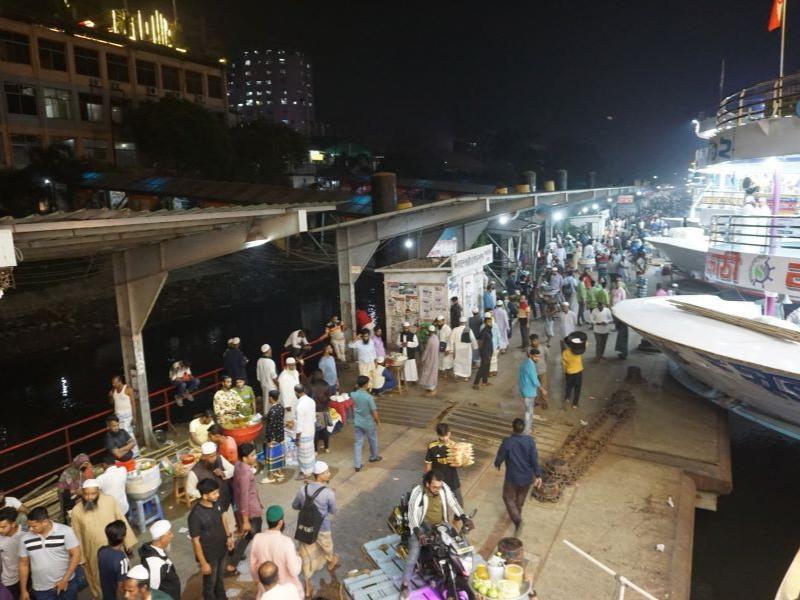
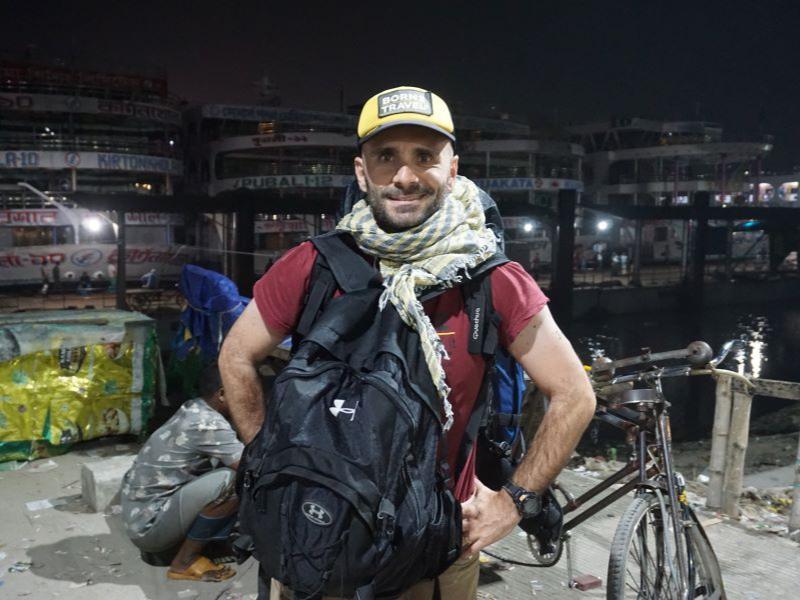

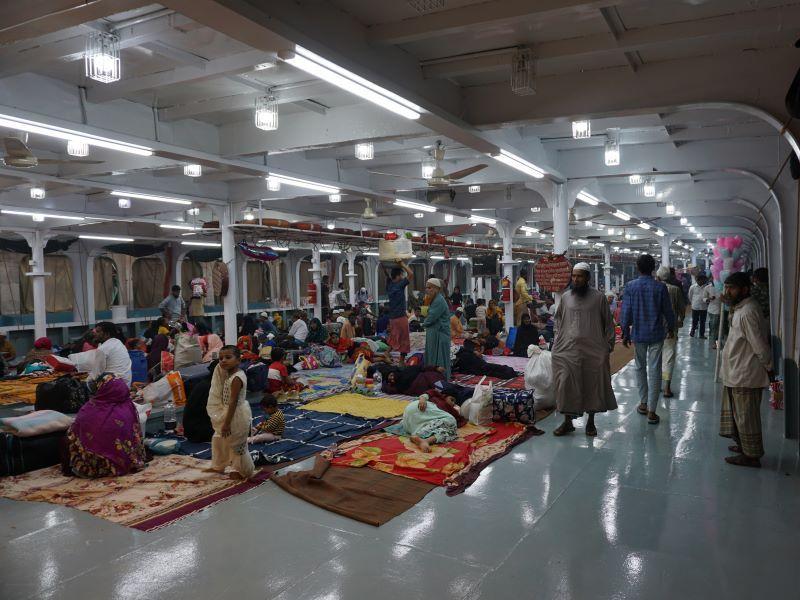

Here we are at dawn in Barisal welcomed by hundreds of tuk tuks waiting for the ferry passengers but fortunately our super faithful Rias is waiting for us and we immediately set off towards Banaripara.
Breakfast in a wooden shack where there was practically nothing but certainly one of the most unforgettable breakfasts of the entire trip.
On board a wooden motorboat between canals full of vegetable and plant sellers, it feels like being in a documentary, it's incredible, we are speechless with emotion.
We stop in the small village of Inderhat where we are welcomed by all the curious people who ask us where we come from, what we do there, if we are Chinese.... Well yes, many here have only seen Indians and Chinese, not looking like Indians for them we are Chinese!
It is a great moment of travel, a great memory for us for the tenderness and sweetness of men and women who freely welcomed us into their small and humble world.








We also stop in the village of Shohagdal to see how they make heavy doormats with the outside of coconuts, all while an entire elementary school stops lessons to run to see us.
Finally we leave again for Bagerhat, this mosque city is one of the three sites declared World Heritage by UNESCO in Bangladesh.
It was founded by the Turkish general Khan Nathan Ali in the early 15th century.
Famous above all for the Shat Gambuji Masjid (the largest mosque with 60 domes), entrance fee $5 very particular for the simplicity of the interior and the brick floor without the usual carpets or rugs.
Tonight we will sleep here in Bagerhat at the Vumi Guesthouse, a nice little hotel but with an excellent little restaurant attached where we will spend a wonderful evening having dinner with Bulu, his wife, Abir (our guide) and Oshti (another local guide of the Riverain Tours).
Before going to sleep we take a tuk tuk ride with Bulu and every corner is a discovery: here some boys select the betel nuts for the pan, here others sharpen and create agricultural tools in iron, everywhere there are vendors of Bengali street food, spicy but not too much.
We head back north, Nora is wearing a wonderful Salwar Kameez bought in Dhaka and looks like a little Bengali princess.
The journey lasts about four hours and we pass through numerous small villages that are always super crowded, always with lively markets, packed with people, rickshaws, tuk tuks and horns.
Every single little town is a terrible chaos and I like all this vitality.
In one of the many towns we notice a large slum, we stop and after a moment we are literally surrounded by many children and women and men intrigued by these strange figures... we distribute here everything we brought from Italy: shoes, clothes, colors, diapers and even if it is only a small drop we hope to have given a few smiles.
In the afternoon we finally arrive in Kushtia, we stay at the Desha Tarc Hotel, very promising from the outside but quite basic inside.
Kushtia is a chaotic town south of Rajshahi division, but practically in the middle of nowhere.
At first glance it might seem strange that a living guru (Tagore) lived here, the famous poet of many Baci Perugina cards, and here is also the tomb of a holy man with a sweet voice and a sensitive vision of life.
We are referring to the Shrine of Lalon Shah, for many Bengalis the visit to the Shrine of Lalon Shah is the only real reason to come to Kushtia and hundreds of them do it.
Lalon Shah is one of the most famous holy men in Bangladesh, his story is very fascinating: a boy born to a Hindu family, seriously ill with high fever and considered more dead than alive, was abandoned on a banana tree trunk directly in the river. He survived and was saved by a Muslim family.
When he returned home and told his whole story to his family, he was sent away, considered an infidel for having been with Muslims. So, having understood that religion was not a bond or a limit, he began to preach the equality of men because humanity rejects all distinctions of caste, class and creed, taking a stand against every form of discrimination and racism.
We witnessed the singing of his followers playing the ektara, a one-stringed instrument, and it was all very engaging.
Before returning we stop at a small shop where they make the famous local sweet: khaza, a sugar sweet with sesame.
We reach the small village of Puthia where the so-called “Kings’ Palace” stands, built by Queen Hem Kumari Debi.
The complex boasts the largest number of Hindu temples in Bangladesh. All built in terracotta, they present a great variety of styles.
We set off again towards Pahardur where we visit the majestic Buddhist monastic complex of Vihara from the eighth century… Indeed, with the passing of time, this huge structure was practically swallowed up by the ground and rediscovered and brought back to light only by the English in 1950.
Today it is a UNESCO World Heritage Site and remains one of the most evocative monuments in the country.
Only in the evening we finally arrive in Bogra welcomed by the beautiful Momo Inn Hotel, a five-star mausoleum in the middle of nowhere where we will spend this night.








We wake up at dawn this morning, at 6:00 we were already walking around the wonderful and picturesque Mahasthan Bazar market, one of the best stocked in Bangladesh, especially because supplies for all the other markets in the country, including the one in Dhaka, leave from here... So you can imagine the quantity of vegetables that are processed and sold.
As in every place we are warmly welcomed by kind smiles, curious eyes and 1000 selfies.
Along the way, in Sirajganj, we visit a small fabric shop and are struck by the effort that goes into making them…. And if you think that they are sold at €1 each…
Finally we visit the temple of the nine gems, an old Hindu temple now in disuse but still very suggestive.
In the late afternoon we finally reach chaotic Dhaka and our wonderful hotel, certainly one of the most beautiful and elegant we have ever stayed in: InterContinental Hotel Dhaka.
Tomorrow morning we leave again with our direct flight of Biman, the Bangladeshi national airline, to Rome.
Error: No feed found.
Please go to the Instagram Feed settings page to create a feed.
10 Responses
Davvero complimenti per questa bellissima ed insolita esperienza che avete effettuato in Bangladesh !!! Grazie a voi per avere reso partecipi nella vostra scoperta
Grazie a te, è stata davvero un’esperienza unica in un paese non abituato al turismo e questa cosa ha reso il tutto indimenticabile
Complimenti per il bellissimo articolo. Un viaggio sicuramente fuori dagli schemi e dalle solite mete. Complimenti per averlo raccontato.
Grazie mille cari ragazzi, è stata una grande scoperta per noi!!
Take love Dear! It was quite a detailed report & nicely done. Happy to see that, you guys were enjoyed the trip around our country. If your time permits, I invite you to come here in future.
Hi bro, we have loved everything of your Country.. of course with all pro and cons but it’s been a such wonderful experience that we really suggest everyone to live
Did they actually ask for your letter of invitation and onward flight ticket to get your VOA. I heard they just need a hotel booking now?
Yes they ask for these docs
Did you take your drone in hand luggage? Did customs cause any problems?
I did and i had no problem at all bringing it